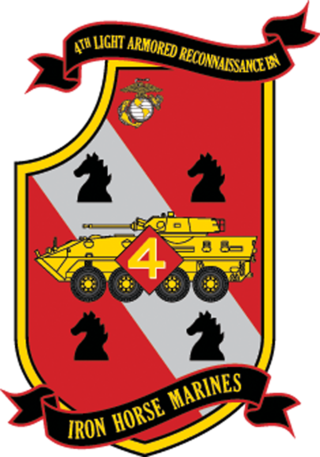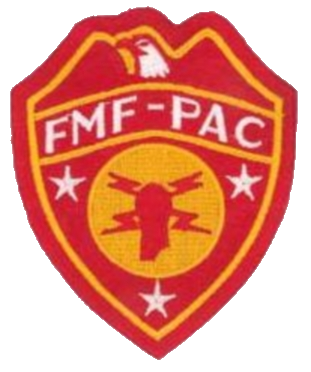
A Marine expeditionary unit is the smallest air-ground task force (MAGTF) in the United States Fleet Marine Force. Each MEU is an expeditionary rapid reaction force ready to any crisis, whether it be disaster aid or a combat mission. Marine amphibious unit (MAU) was the name used until the late 1980s.

Force Reconnaissance (FORECON) is a United States Marine Corps deep reconnaissance unit which supplies military intelligence to the command element of the Marine Air-Ground Task Force (MAGTF). Force Reconnaissance companies unlike USMC division reconnaissance report to the Marine expeditionary force (MEF) and provide direct action and deep reconnaissance during large-scale operations.

The United States Marine Corps Reconnaissance Battalions are the reconnaissance assets of Marine Air-Ground Task Force that provide division-level ground and amphibious reconnaissance to the Ground Combat Element within the United States Marine Corps. Division reconnaissance teams are employed to observe and report on enemy activity and other information of military significance in close operations. The Military Occupational Specialty code for Reconnaissance Marine is 0321.

2nd Light Armored Reconnaissance Battalion is a fast and mobilized armored terrestrial reconnaissance battalion of the United States Marine Corps. Their primary weapon system is the 8-wheeled LAV-25 and they fall under the command of the 2nd Marine Division and II Marine Expeditionary Force. The unit is based out of the Marine Corps Base Camp Lejeune, North Carolina. The current mission statement of the battalion is: To perform combined arms reconnaissance and security missions in support of the Ground Combat Element (GCE) of a Marine Air-Ground Task Force (MAGTF). Its mission is to conduct reconnaissance, security and economy of force operations, and, within its capabilities, limited offensive or defensive operations that exploit the unit's mobility and firepower.
Radio Battalions are tactical signals intelligence units of Marine Corps Intelligence. There are currently three operational Radio Battalions in the Marine Corps organization: 1st, 2nd, and 3rd. In fleet operations, teams from Radio Battalions are most often attached to the command element of Marine Expeditionary Units.
In the United States Marine Corps, a Marine Air–Ground Task Force is the principal organization for all missions across the range of military operations. MAGTFs are a balanced air–ground, combined arms task organization of Marine Corps forces under a single commander that is structured to accomplish a specific mission. The MAGTF was formalized by the publishing of Marine Corps Order 3120.3 in December 1963 "The Marine Corps in the National Defense, MCDP 1-0". It stated:

The 3rd Reconnaissance Battalion conducts amphibious and ground reconnaissance in support of the 3rd Marine Division and Marine Forces Pacific (MarForPac), operating in the commander's areas of influence. The Battalion is based out of Camp Schwab, a satellite base of Marine Corps Base Camp Smedley D. Butler. It is geographically located on the Okinawa Prefecture in Japan.

1st Reconnaissance Battalion is a reconnaissance battalion in the United States Marine Corps. It is a stand-alone battalion with no parent regiment. Instead, it falls directly under the command of the 1st Marine Division. 1st Recon Bn is located at Marine Corps Base Camp Pendleton in San Diego, California.

4th Light Armored Reconnaissance Battalion is a United States Marine Corps Light Armored Reconnaissance battalion of the Marine Corps Reserve. Their primary weapon system is the LAV-25 and they are part of the 4th Marine Division and Marine Forces Reserve. The unit headquarters is at Camp Pendleton, California, but other units in the battalion are located throughout the United States. 4th LAR Bn is the largest combat battalion in the Marine Corps, with 7 companies.

The 2nd Reconnaissance Battalion is a reconnaissance battalion in the United States Marine Corps. Located at Marine Corps Base Camp Lejeune, North Carolina, the battalion falls under the command of the 2nd Marine Division and the II Marine Expeditionary Force.

The 4th Reconnaissance Battalion is a reserve reconnaissance battalion in the United States Marine Corps. It falls under the 4th Marine Division and Marine Forces Reserve.

The United States Marine Corps is organized within the Department of the Navy, which is led by the Secretary of the Navy (SECNAV). The most senior Marine commissioned officer is the Commandant of the Marine Corps, responsible for organizing, recruiting, training, and equipping the Marine Corps so that it is ready for operation under the command of the unified combatant commanders. The Marine Corps is organized into four principal subdivisions: Headquarters Marine Corps, the Operating Forces, the Supporting Establishment, and the Marine Forces Reserve.

The United States Marine Corps's Amphibious Reconnaissance Battalion, formerly Company, was a Marine Corps special operations forces of United States Marine and Hospital corpsman that performed clandestine operation preliminary pre–D-Day amphibious reconnaissance of planned beachheads and their littoral area within uncharted enemy territory for the joint-Navy/Marine force commanders of the Pacific Fleet during World War II. Often accompanied by Navy Underwater Demolition Teams and the early division recon companies, these amphibious recon platoons performed more reconnaissance missions than any other single recon unit during the Pacific campaigns.

A Maritime Special Purpose Force (MSPF) is a United States Marine Corps specialized sub-unit of a Marine expeditionary unit. A MSPF is deployed to give the commanders low profile, two-platoon surgical emplacement in the accessible littoral regions. The MSPF provides the enhanced operational capability and precision skills to complement, enable, and execute selected conventional, maritime special operations. They can also perform operations not resident in traditional amphibious raid companies.
The United States Marine Corps is tasked by Department of Defense directive to "conduct complex expeditionary operations in the urban littorals and other challenging environments" and "conduct amphibious operations, including engagement, crisis response, and power projection operations to assure access." Before 2006, the Marine Corps was the only branch of the Armed Forces that did not have any of its special warfare elements participating in the United States Special Operations Command (USSOCOM), due to confining its special operations capabilities only for the purpose to the Fleet Marine Force.
The reconnaissance mission within the United States Marine Corps is divided into two distinct but complementary aspects; Marine Division Recon and Force Reconnaissance.
The United States Marine Corps Scout and Sniper companies and the Scouts (Tank) companies of the tank battalions were the first among the division's reconnaissance assets. They existed around the same exact moment when 1st and 2nd Marine Division were created. In 1941, each regiment had a scout and sniper platoon. They were assigned to the regimental Headquarters and Service Company. These companies were used in variety of tasks and, on occasion in severe combat, were used as "spare" rifle companies. When 6th Marine Division deactivated after the end of World War II, its recon assets also deactivated. Only the current Marine Division Recon Battalions that exist today hold history reference to the Scout and Sniper Companies.

1st Force Reconnaissance Company conducted deep reconnaissance and direct action raids in support of I Marine Expeditionary Force requirements across the range of military operations to include crisis response, expeditionary operations and major combat operations. 1st Force Recon Company was deactivated on 26 October 2006 and the majority of the personnel were used to establish the 1st Marine Special Operations Battalion.

3rd Force Reconnaissance Company is a force reconnaissance unit of the United States Marine Corps Reserve. The company is located in Mobile, Alabama.

















